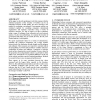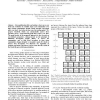488 search results - page 37 / 98 » Hubs, authorities, and communities |
WWW
2006
ACM
14 years 9 months ago
2006
ACM
In this paper we describe preliminary work that examines whether statistical properties of the structure of websites can be an informative measure of their quality. We aim to deve...
PCRCW
1997
Springer
14 years 26 days ago
1997
Springer
In recent years, theChaos Project at theUniversityofWashingtonhas analyzed and simulated a dozen routing algorithms. Three new routing algorithms have been invented; of these, the...
CORR
2011
Springer
13 years 3 months ago
2011
Springer
Complex networks have been characterised by their specific connectivity patterns (network motifs), but their building blocks can also be identified and described by node-motifs—...
ICDE
2008
IEEE
14 years 10 months ago
2008
IEEE
Given publication titles and authors, what can we say about the evolution of scientific topics and communities over time? Which communities shrunk, which emerged, and which split, ...
WWW
2007
ACM
14 years 9 months ago
2007
ACM
DBin is a Semantic Web application that enables groups of users with a common interest to cooperatively create semantically structured knowledge bases. These user groups, which we...


